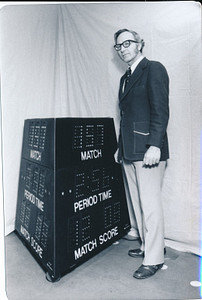
Founded by Al Kurtenbach and Duane Sander in 1968, Daktronics has become a leading design and manufacturing company in the world with electronic scoreboards, programmable display systems and large screen video displays.
From selling electronic voting systems and Matside wrestling scoreboards, to nine scoreboards for the 1980 winter Olympics and now having production throughout the world, Daktronics now has more than 2,500 employees.
Keeping South Dakota State University students in South Dakota has always been important to Kurtenbach. “We really built our company primarily on SDSU graduates,” Kurtenbach said.
The Collegian recently sat down with Al Kurtenbach. The interview has been edited for clarity and space.
What is Daktronics?
“Daktronics is a technology company focusing on the area of communications and specifically on visual communications and the equipment used for this communication, large programmable displays. We stimulate growth by staying current with technology. We’re design, development and manufacture. And we have our own marketing and sales operation,” Kurtenbach said.
When you first started this business, did you ever imagine that it would become what it is now?
“No, we had different things in mind. We found this path and pursued it,” Kurtenbach said.
Are you glad you did?
“Oh yeah,” Kurtenbach said.
What was the biggest challenge when starting your business?
“First thing we addressed was to raise some money so that was probably the first challenge. So, we organized a small regulation, a stock offering and raised money to fund our operation,” Kurtenbach said.
If you were to give advice to a young adult wanting to start their own company, what would it be?
“Bring something to the table and have an idea that you would like to pursue. You need to have this idea that something either you’re going to have this ability to deliver or you’re going to have the ability to develop and manufacture some piece of hardware. You’ve got to have a market for the service or the product. So, you have to think through and plan how there has to be a market but there has to be a path to that,” Kurtenbach said.
How does Brookings, being a college town, influence your business? Also, is it a goal of Daktronics’ to keep SDSU students in the Brookings area with the job opportunities that you guys have? If so, why?
“The university really brings the talent to town. I say that Brookings has about 2,000 immigrants every fall in the form of primarily freshman students, and those students, well not all of them graduate, but they have around for I say from two to six years. And until you have time to meet them, and find out what their interests are, and see if you have a joint interest and if the students upon graduation might be interested in staying in South Dakota. And in particular for us, staying in Brookings. So, if students who are interested in staying in touch with their family after graduation, and if they are from this general area that SDSU draws students from, then it might be a really good fit. So, you could say it’s kind of a goal to keep some of these students in the area because our greatest asset in South Dakota is our young people,” Kurtenbach said.
What do you think one major key to success is when starting a company?
“Well, I think one major key is perseverance. You got to want to, and you got to work at it. And there are going to be disappointments, so you have to persevere. And it’s probably not always going to be easy,” Kurtenbach said.
Other than starting your business, what would you say is your greatest success?
“Well, we have five children. They all have college degrees, are professionals and some of them are officers in Daktronics. And I think my wife, her perseverance, helping them (their children) grow,” Kurtenbach said.
What are some words that you live by?
“Well, the Lord’s Prayer is one that I say every night before I go to sleep. So, I remember those words. But, as I mentioned earlier, perseverance is very important. And I have three words listed around here [Daktronics] somewhere: honesty, helpfulness, and humanity,” Kurtenbach said.
What are some of the most unique places that your scoreboards have been put up?
“We kind of have segmented the markets. We have what we call large sport venues, and those are quite exciting. But we also have just ordinary what we call the commercial market which is important. We don’t do much with the Olympics anymore, but for a period of years we had displays in most of the Olympic Games. That was from about 1980 through I think 2012,” Kurtenbach said.
What gave you the desire to write your book?
“People told me I should write a book, then somebody came in and said ‘I’d really like to write a book about you and I need your help.’ And so, that’s really the straw that turned the corner for me. I was pleased because like I said, I was encouraged to do it and I thought it would be good to leave a little history of the way the company came to exist. So, I thought that was good. For the approach he had already jot it down in a kind of table of contents and indicated what areas he would like me to contribute in,” Kurtenbach said.















